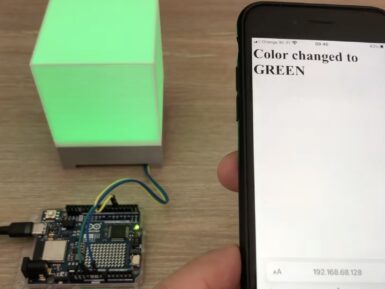
NFC/RFID reader with two transponders
NFC/RFID reader/writer with 1 status LED, antenna integrated on PCB, I²C, SPI, and HSU (High Speed UART) communication interface
Overview
It can function as an RFID card reader/writer, NFC reader with Android smartphone and in wireless mode with two identical devices.
It can be used with Arduino to create access control devices.
The package includes the reader, a keychain transponder, a card transponder and connection cables.
Tech specs
- Power supply: from 3.3 V to 5 V
- Compact and easy to integrate into your project
- Supports interface: I²C, SPI and HSU (High Speed UART), selectable via dip-switch
- Supports RFID read/write, P2P communication between two identical modules, NFC with Android smartphone
- Supports RFID read/write:
- Mifare 1k, 4k, Ultralight, and DesFire cards
- ISO/IEC 14443-4 cards such as CD97BX, CD light, Desfire, P5CN072 (SMX)
- Innovision Jewel cards such as IRT5001 card
- FeliCa cards such as RCS_860 and RCS_854 - Reading distance (mm): max. 50-70
- Dimensions (mm): 43x41x4
Conformities
Get Inspired

Syntaxx is powered by three Arduino boards, each handling specific functions to create a seamless and dynamic performance:

It can be tough to get started with building an Internet of Things (IoT) project from the ground-up, as getting connected, serving a webpage, and managing other devices can all be a challenge to a beginner. This is why the YouTuber known as “Mario’s Ideas” made an end-to-end tutorial that details everything one might need to build a smart RGB lamp. Because the Arduino UNO R4 WiFi contains an ESP32-S3 chip for its Wi-Fi radio and Renesas RA4M1 microcontroller, it was the perfect candidate. Mario’s sketch begins with a call to initialize the Wi-Fi module before attempting to connect to his local access point. Once finished, it enters a loop that continuously checks if a client has connected to the web server, and if one has, reads the requested path while also seeing if the string contains “/H” to denote an “ON” command to set the LED. Toggling an LED is useful, but Mario wanted to take things a step further by building a tangible — in this case a lamp. His 3D-printed enclosure features a recessed base and translucent cube for diffusing the light emitted by a grid of NeoPixels. Controlling the color was just as easy since any browser could still send a request path containing a color and get back the lamp’s updated status. To see more about this IoT lamp project, you can watch Mario’s video below!








